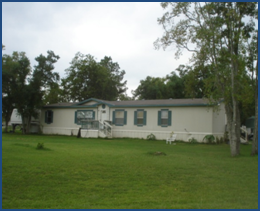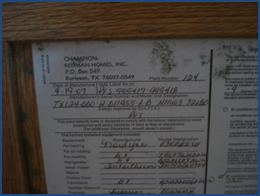Module 2 – Mortgage Field Services / Default Inspections
Chapter 14: Other Inspection Types
Mobile Home Inspections
A mobile home inspection can be any of the three types of inspections, but will require additional information because of the property type. As stated in the commonalities chapter, a mobile or manufactured home is a home that is not permanently affixed to the parcel of land on which it sits. Additional information that should be reported includes:
VIN and/or HUD number
The Vehicle Identification Number (VIN) number can be located on the front end frame of the mobile home. It is usually painted onto the frame and may be hidden by skirting or worn off from age. It is also located inside the mobile home on a label sheet affixed somewhere in the mobile home – common locations include inside a kitchen cabinet, an electrical panel, or a bedroom closet. On that label you can also find the manufacture date as well as the make and model of the mobile home. Unfortunately, that can also be missing if the occupant has removed the label.
The HUD number is a number that begins with three letters followed by six numbers and is engraved into a metal plate that is attached permanently of each section of the mobile home. It may be on the back or the side of the section. Each section will have a different number, but will be sequential (i.e. RAD 000001).
Visit http://portal.hud.gov/hudportal/HUD?src=/program_offices/housing/rmra/mhs/mhslabels for more information regarding mobile home identification numbers
Presence of foundation
Is the mobile home permanently affixed to the ground?
Size
● Single
● Double
● Triple-wide
Is it in a mobile home park?
If so, include the name and telephone number of the park

Mobile Home

HUD Tag

Mobile Home Label
Interior Inspections
Interior inspections are ordered by the client to determine condition of interior and exterior of the property. These are only completed on vacant homes.
● The inspector must first verify the property is vacant and secure before attempting to enter the house. Walk the entire property before entering the home.
● If the property is secure, the inspector should gain access using the keys provided either by the servicing company or a lockbox at the property.
● Take photos of every room and any damages/hazards found at the property.
● Take photos of appliances present at the property.
● Other information may also be required pursuant to the client order.
● If the inspector finds that the property is occupied, do not enter the home and report the property as occupied, giving multiple reasons for occupancy status.
● If the property is vacant, but is unsafe for the inspector to enter for some reason, treat the inspection as an exterior inspection only and report why it was not safe to enter.
● If the inspector is unable to gain access to the property, photos must be provided to show why he was unable to gain access.
Sale Date Inspections
Sale date inspections are required to be completed on a specific date. They may not be completed early. Sale date inspections are ordered to verify occupancy and may include determining names of those living at the property. The sale date inspection may be either a contact or no contact inspection. It is important to follow the instructions of the client.
Window Inspections
The Department of Housing and Urban Development (HUD) requires the mortgagee to conduct a visual inspection of a property if a payment is not received within forty-five (45) days of the due date and efforts to reach the mortgagor by phone or other means have been unsuccessful. Subsequent inspections must be performed 25-35 days following the prior inspection. Completion of these inspections during this window is critical and failure to adhere to the required timeframe will likely result in non-payment for the service. The client will provide the specific window timeframe and due back date required for each of these inspections. Be aware that these inspections can be for any inspection type, including interior inspections.
